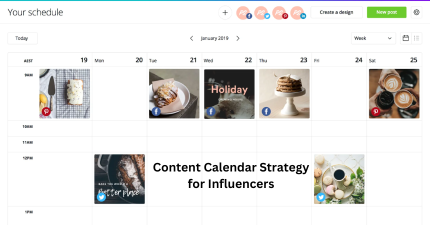
- 06 Nov, 2024
The Ultimate Guide to Becoming a Successful Food Influencer
The food industry has exploded on social media, with food influencers leading the way. They captivate audiences with vibrant images, creative recipes, and engaging content. But what does it take to become a successful food influencer? In this guide, we’ll cover essential steps to help you grow your influence in the food space, build a loyal following, and collaborate with top brands. StarJD gives you a chance where every influencer to explore their talent and skills and also collaborate with known brands.
Define Your Niche and Personal Brand
Food is a broad category, so narrowing down your niche is key to standing out. Start by identifying your unique angle in the food industry:
- Recipe Developer: Share original recipes with tips for cooking techniques.
- Restaurant Reviewer: Explore and review local or international dining spots.
- Healthy Eating: Focus on nutritious recipes, fitness tips, and healthy lifestyles.
- Food Photography: Create stunning visuals that inspire others to appreciate food.
- Cultural Cuisine: Highlight recipes, ingredients, and traditions from specific cultures.
Your niche will guide your content and attract a targeted audience. Once you’ve chosen your niche, think about your brand. Is it casual and fun, or refined and educational? Consistency in your tone and style will help build a recognizable brand image.
Invest in Quality Photography and Videography
Visuals are the foundation of food content on social media. High-quality photos and videos are essential for attracting viewers and engaging followers. Here are some basic tips:
- Use Natural Light: Find a bright spot in your home or invest in soft lighting equipment. Natural light creates vibrant, appealing photos.
- Experiment with Angles: Overhead shots, close-ups, and side views highlight different aspects of the dish.
- Focus on Composition: Arrange the food thoughtfully, add garnishes, and use props to enhance the scene.
- Learn Editing Skills: Apps like Lightroom, VSCO, or Snapseed can help you edit photos to make colors pop.
For video content, try incorporating recipe videos, food preparation techniques, or behind-the-scenes shots. These formats engage viewers, especially on platforms like Instagram Reels, TikTok, and YouTube Shorts.
Create Engaging Content and Captions
Your photos may catch your attention, but captions build a connection. Use captions to tell a story, share personal anecdotes, or provide cooking tips. An engaging caption can encourage comments, questions, and interaction.
Examples of engaging captions include:
- Sharing a recipe story or how you discovered it.
- Asking followers for their cooking tips.
- Describing the flavor and texture of the dish.
Try to include SEO-friendly keywords in your captions, such as "easy dessert recipe," "healthy meals," or "authentic Italian pasta." These keywords help improve discoverability on platforms like Instagram and Pinterest.
Utilize Multiple Social Media Platforms
While Instagram is popular for food content, expanding to other platforms like YouTube, TikTok, Pinterest, and even a personal blog can help you reach a broader audience. Each platform serves a unique purpose:
- Instagram: Great for food photos, short videos, Stories, and Reels.
- YouTube: Ideal for long-form cooking tutorials, reviews, or vlogs.
- TikTok: Perfect for short, engaging recipe videos or quick food tips.
- Pinterest: A powerful platform for food bloggers, as recipes and food images often get shared here.
Use hashtags relevant to your niche, such as #FoodieLife, #FoodPhotography, or #RecipeInspo. Tailor your content to each platform's format for maximum engagement.
Engage Actively with Your Audience
Audience engagement is key to building a loyal following. Regularly interact with your followers by responding to comments, answering questions, and engaging in conversations. You can also engage through:
- Polls and Q&A sessions on Instagram Stories to understand what content your audience enjoys.
- Live cooking sessions where you can showcase recipes in real-time and interact with followers.
- Giveaways that encourage followers to engage and share your content.
Building relationships with your followers fosters trust and makes your content more impactful. Loyal followers are more likely to share your content, which can help grow your audience organically.
Collaborate with Other Influencers and Brands
Collaborations with other food influencers can introduce you to new audiences. Partner with influencers who share a similar niche but have a unique style. You could do a recipe swap, a joint cooking session, or a themed content series. Cross-promotion benefits both influencers by exposing them to each other's followers.
As you grow, brands may reach out for partnerships. When choosing brands to collaborate with, ensure they align with your values and content. Authenticity is key, as followers appreciate honest, genuine recommendations.
Examples of brand collaborations include:
- Sponsored recipe posts using specific ingredients.
- Restaurant reviews or tasting experiences.
- Product reviews for cooking tools, kitchen gadgets, or meal kits.
Keep Up with Food Trends
Food trends are constantly evolving, and staying updated can keep your content fresh and relevant. Trends may include new ingredients, cooking techniques, dietary preferences, or viral recipes. Some ways to stay informed include:
- Following popular food blogs, websites, and magazines.
- Checking trending topics on Pinterest, TikTok, and Instagram.
- Attending food festivals, trade shows, or virtual events.
Creating content based on popular trends can help your posts gain traction and reach a larger audience, as users often search for trending topics.
Consistently Post High-Quality Content
Consistency is key to maintaining and growing your audience. Determine a posting schedule that works for you, whether it's daily, a few times a week, or biweekly. Consistency not only keeps your audience engaged but also helps with algorithm performance on platforms like Instagram and YouTube.
However, prioritize quality over quantity. Posting high-quality content less frequently is more effective than posting lower-quality content daily. Use scheduling tools like Later, Buffer, or Hootsuite to plan and manage your content calendar.
Track and Analyze Your Performance
Understanding which content resonates with your audience is essential. Use analytics tools to monitor performance metrics, such as engagement rate, impressions, reach, and follower growth. These insights can help you refine your content strategy.
Most social media platforms offer built-in analytics. Some metrics to track include:
- Engagement rate: Indicates how much your audience interacts with your posts.
- Follower growth: This shows how well your content attracts new followers.
- Reach and impressions: Indicates how far your content spreads across the platform.
Tracking these metrics can reveal patterns in what content performs best, allowing you to focus on what your audience loves most.
Monetize Your Food Influencer Platform
As your influence grows, there are multiple ways to monetize your platform:
- Sponsored Content: Collaborate with brands on sponsored posts, where you feature their products in your recipes or food reviews.
- Affiliate Marketing: Partner with brands to earn a commission for promoting their products, such as kitchen appliances or gourmet ingredients.
- Online Cooking Classes: Offer virtual cooking sessions, either one-on-one or in groups.
- Selling eBooks: Compile your original recipes, meal plans, or food photography tips into an eBook for sale.
- Ad Revenue: Platforms like YouTube and a personal blog can generate income from ads, especially as your traffic increases.
Diversifying your income streams helps build a sustainable influencer career. Focus on methods that feel authentic and align with your brand, as this will resonate best with your followers.
Final Thoughts
Becoming a successful food influencer requires dedication, creativity, and consistency. From crafting visually appealing content and engaging with your audience to collaborating with brands and keeping up with trends, each step contributes to building a strong presence in the food community.
Remember, authenticity is key. Share your passion for food genuinely, and your audience will respond. Use these tips to grow your influence, inspire others, and enjoy the journey of becoming a top food influencer. Whether you’re sharing recipes, reviewing restaurants, or simply exploring new cuisines, there’s a place for you in the food influencer world.




